2018 NISSAN VERSA fuel pressure
[x] Cancel search: fuel pressurePage 18 of 354

Warning
lightName Page
or
Anti-lock Braking
System (ABS)
warning light2-13
or
Brake warning
light2-13
Charge warning
light2-14
Door open warn-
ing light2-14
Engine oil pres-
sure warning light2-14
High temperature
warning light (red)
(if so equipped)2-14
Warning
lightName Page
or
Low fuel warning
light2-15
Low tire pressure
warning light2-15
Power steering
warning light2-17
Seat belt warning
light and chime (if
so equipped)2-17
Supplemental air
bag warning light2-17
Indicator
lightName Page
Continuously
Variable Trans-
mission (CVT) po-
sition indicator
light2-18
Cruise main
switch indicator
light (if so
equipped)2-18
Front fog light in-
dicator light (if so
equipped)2-18
Front passenger
air bag status
light2-18
High beam indi-
cator light (blue)2-18
Malfunction Indi-
cator Light (MIL)2-18
WARNING AND INDICATOR LIGHTS
Illustrated table of contents0-9
Page 93 of 354
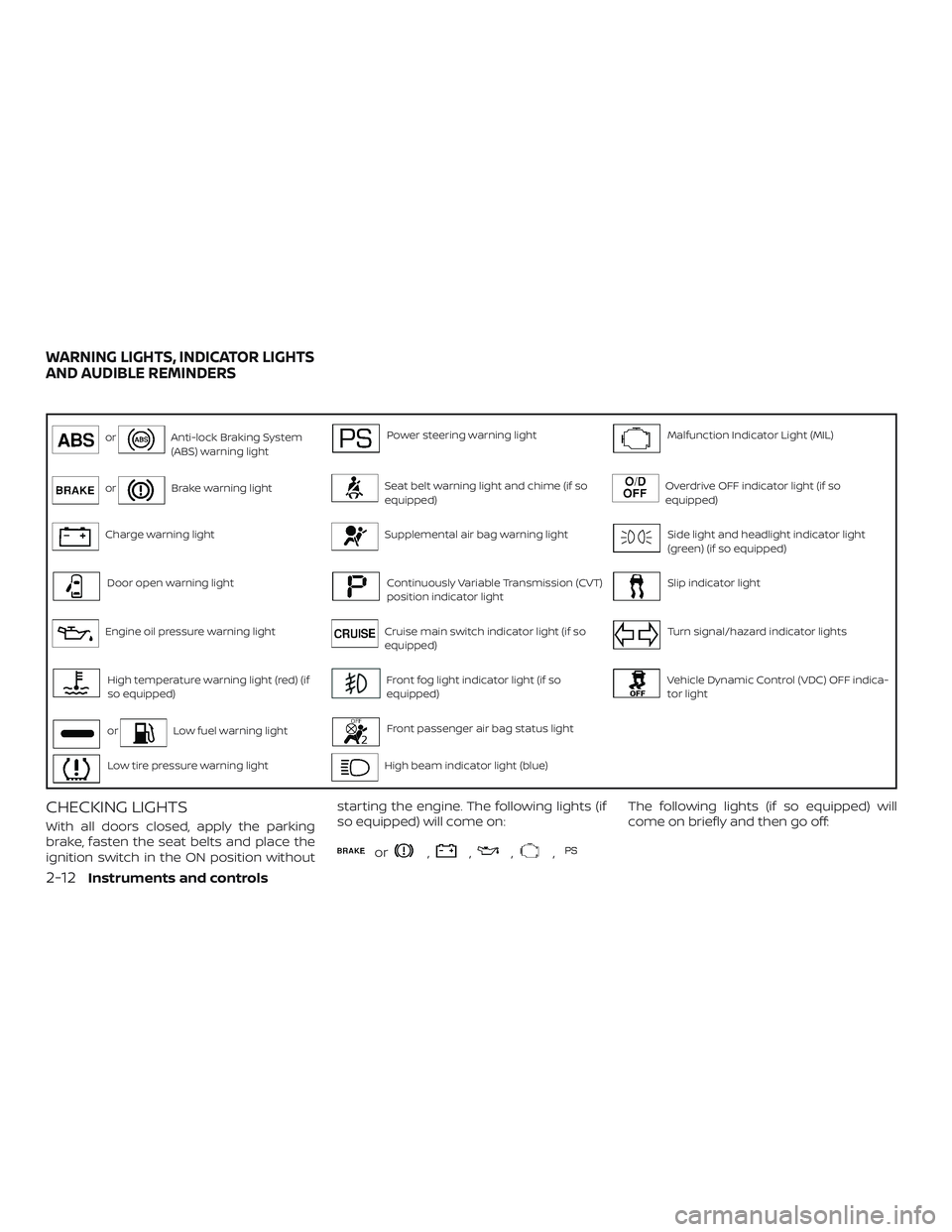
orAnti-lock Braking System
(ABS) warning lightPower steering warning lightMalfunction Indicator Light (MIL)
orBrake warning lightSeat belt warning light and chime (if so
equipped)Overdrive OFF indicator light (if so
equipped)
Charge warning lightSupplemental air bag warning lightSide light and headlight indicator light
(green) (if so equipped)
Door open warning lightContinuously Variable Transmission (CVT)
position indicator lightSlip indicator light
Engine oil pressure warning lightCruise main switch indicator light (if so
equipped)Turn signal/hazard indicator lights
High temperature warning light (red) (if
so equipped)Front fog light indicator light (if so
equipped)Vehicle Dynamic Control (VDC) OFF indica-
tor light
orLow fuel warning lightFront passenger air bag status light
Low tire pressure warning lightHigh beam indicator light (blue)
CHECKING LIGHTS
With all doors closed, apply the parking
brake, fasten the seat belts and place the
ignition switch in the ON position withoutstarting the engine. The following lights (if
so equipped) will come on:
or,,,,
The following lights (if so equipped) will
come on briefly and then go off:
WARNING LIGHTS, INDICATOR LIGHTS
AND AUDIBLE REMINDERS
2-12Instruments and controls
Page 96 of 354

CAUTION
If the high temperature warning light
illuminates while the engine is running,
it may indicate the engine temperature
is extremely high. Stop the vehicle
safely as soon as possible. If the vehicle
is overheated, continuing vehicle op-
eration may seriously damage the en-
gine. For additional information, refer
to “If your vehicle overheats” in the “In
case of emergency ” section of this
manual.
orLow fuel warning
light
This light comes on when the fuel level in
the fuel tank is getting low. Refuel as soon
as it is convenient, preferably before the
fuel gauge reaches 0 (Empty).There will be
a small reserve of fuel in the tank when
the fuel gauge reaches 0 (Empty), show-
ing no more fuel bars.
Low tire pressure warning
light
Your vehicle is equipped with a Tire Pres-
sure Monitoring System (TPMS) that moni-
tors the tire pressure of all tires except the
spare.The low tire pressure warning light warns
of low tire pressure or indicates that the
TPMS is not functioning properly.
Af ter the ignition switch is placed in the ON
position, this light illuminates for about
1 second and turns off.
Low tire pressure warning
If the vehicle is being driven with low tire
pressure, the warning light will illumi-
nate.
A CHECK TIRE PRES (pressure) warning
message is also displayed in the odom-
eter.
When the low tire pressure warning light
illuminates, you should stop and adjust
the tire pressure of all four tires to the
recommended COLD tire pressure shown
on the Tire and Loading Information la-
bel located in the driver’s door opening.
The low tire pressure warning light does
not automatically turn off when the tire
pressure is adjusted. Af ter the tire is in-
flated to the recommended pressure,
the vehicle must be driven at speeds
above 16 mph (25 km/h) to activate the
TPMS and turn off the low tire pressure
warning light. Use a tire pressure gauge
to check the tire pressure.The low tire pressure warning light remains
illuminated until the tires are inflated to the
recommended COLD tire pressure. The
CHECK TIRE PRES warning message is dis-
played each time the ignition switch is
placed in the ON position as long as the low
tire pressure warning light remains illumi-
nated.
For additional information, refer to "Check
tire pressure warning message" in this sec-
tion and “Tire Pressure Monitoring System
(TPMS)” in the “Starting and driving” section
and in the “In case of emergency” section of
this manual.
TPMS malfunction
If the TPMS is not functioning properly, the
low tire pressure warning light will flash for
approximately 1 minute when the ignition
switch is placed in the ON position. The
light will remain on af ter 1 minute. Have the
system checked. It is recommended that
you visit a NISSAN dealer for this service.
The "CHECK TIRE PRES" warning does not
appear if the low tire pressure warning light
illuminates to indicate a TPMS malfunction.
Instruments and controls2-15
Page 142 of 354
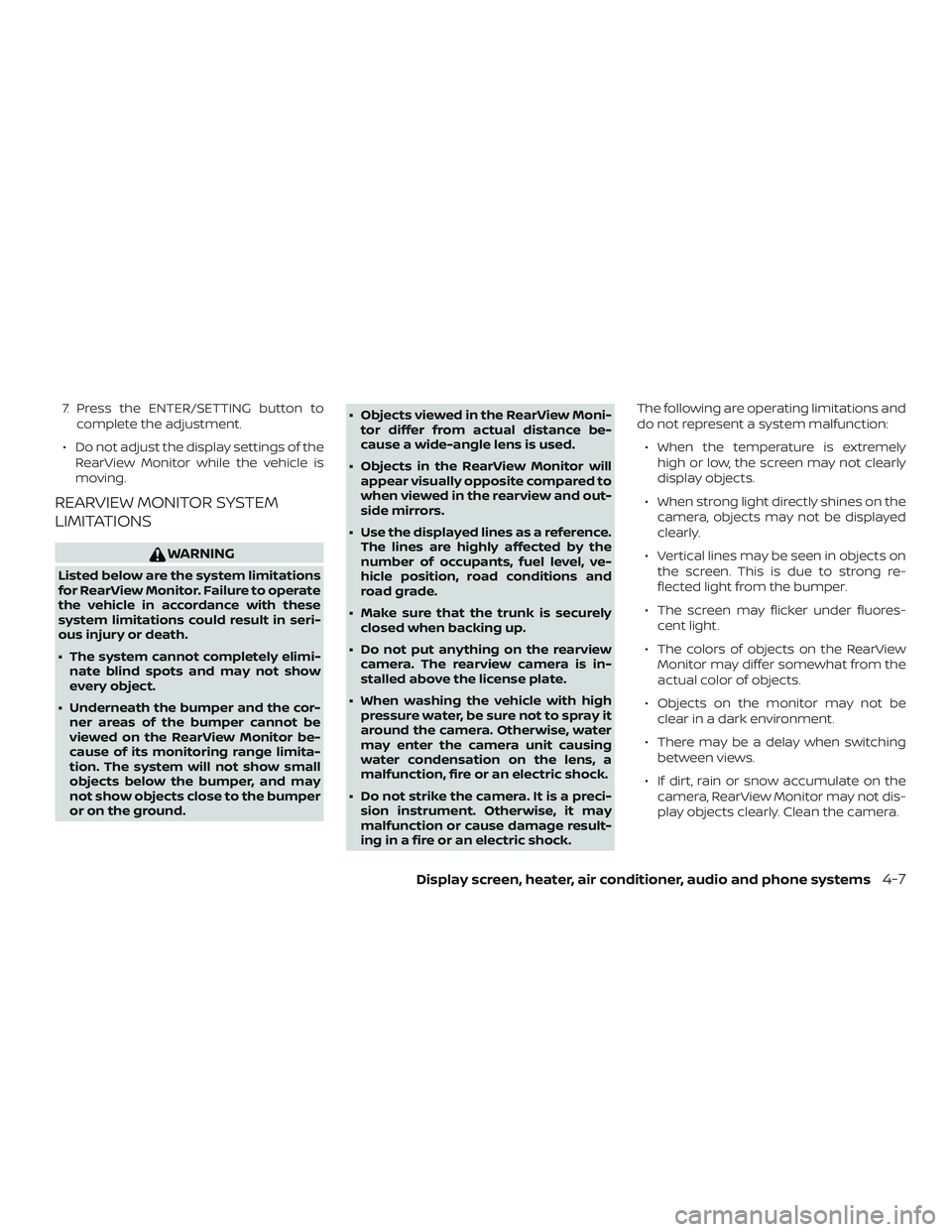
7. Press the ENTER/SETTING button to
complete the adjustment.
∙ Do not adjust the display settings of the
RearView Monitor while the vehicle is
moving.
REARVIEW MONITOR SYSTEM
LIMITATIONS
WARNING
Listed below are the system limitations
for RearView Monitor. Failure to operate
the vehicle in accordance with these
system limitations could result in seri-
ous injury or death.
∙ The system cannot completely elimi-
nate blind spots and may not show
every object.
∙ Underneath the bumper and the cor-
ner areas of the bumper cannot be
viewed on the RearView Monitor be-
cause of its monitoring range limita-
tion. The system will not show small
objects below the bumper, and may
not show objects close to the bumper
or on the ground.∙ Objects viewed in the RearView Moni-
tor differ from actual distance be-
cause a wide-angle lens is used.
∙ Objects in the RearView Monitor will
appear visually opposite compared to
when viewed in the rearview and out-
side mirrors.
∙ Use the displayed lines as a reference.
The lines are highly affected by the
number of occupants, fuel level, ve-
hicle position, road conditions and
road grade.
∙ Make sure that the trunk is securely
closed when backing up.
∙ Do not put anything on the rearview
camera. The rearview camera is in-
stalled above the license plate.
∙ When washing the vehicle with high
pressure water, be sure not to spray it
around the camera. Otherwise, water
may enter the camera unit causing
water condensation on the lens, a
malfunction, fire or an electric shock.
∙ Do not strike the camera. It is a preci-
sion instrument. Otherwise, it may
malfunction or cause damage result-
ing in a fire or an electric shock.The following are operating limitations and
do not represent a system malfunction:
∙ When the temperature is extremely
high or low, the screen may not clearly
display objects.
∙ When strong light directly shines on the
camera, objects may not be displayed
clearly.
∙ Vertical lines may be seen in objects on
the screen. This is due to strong re-
flected light from the bumper.
∙ The screen may flicker under fluores-
cent light.
∙ The colors of objects on the RearView
Monitor may differ somewhat from the
actual color of objects.
∙ Objects on the monitor may not be
clear in a dark environment.
∙ There may be a delay when switching
between views.
∙ If dirt, rain or snow accumulate on the
camera, RearView Monitor may not dis-
play objects clearly. Clean the camera.
Display screen, heater, air conditioner, audio and phone systems4-7
Page 212 of 354
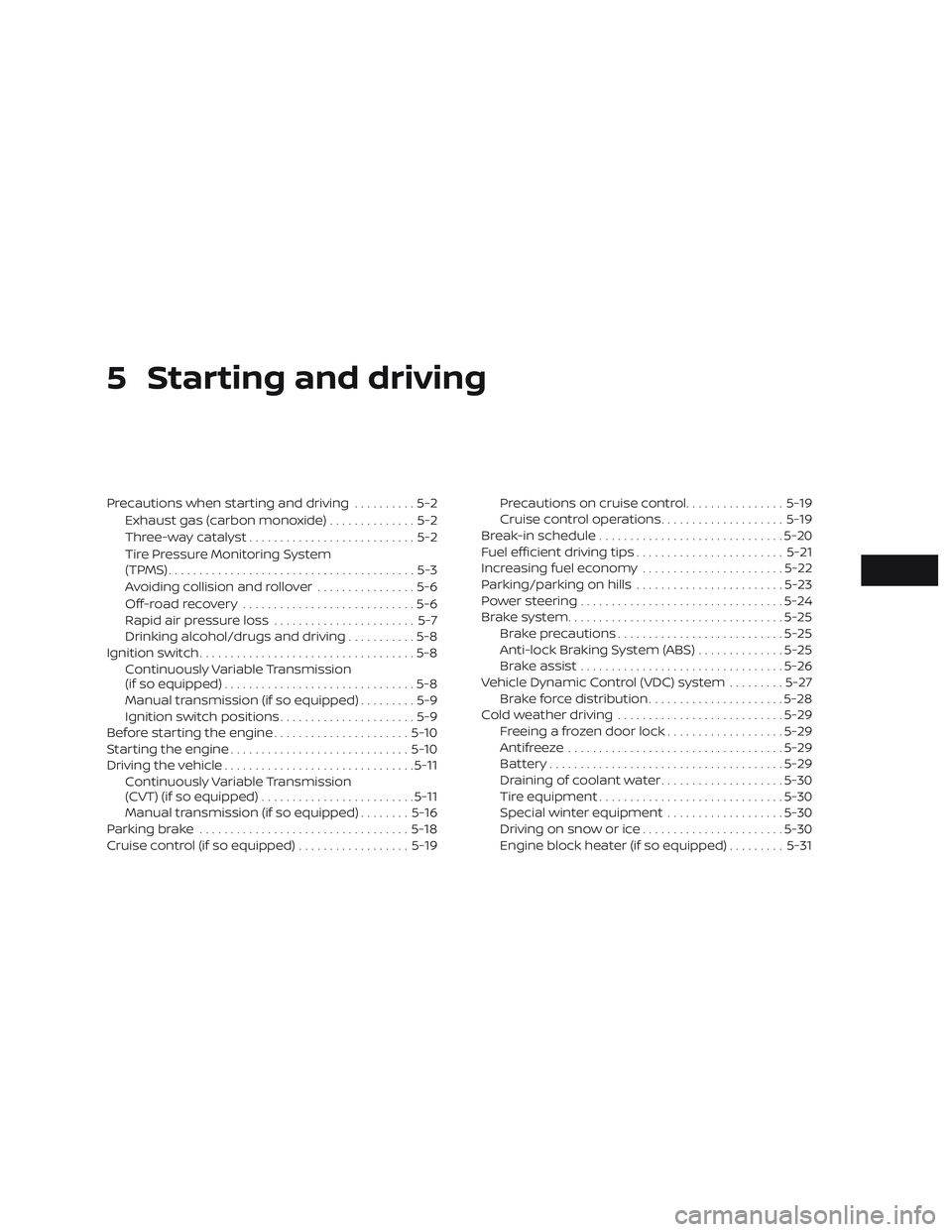
5 Starting and driving
Precautions when starting and driving..........5-2
Exhaust gas (carbon monoxide)..............5-2
Three-way catalyst...........................5-2
Tire Pressure Monitoring System
(TPMS)........................................5-3
Avoiding collision and rollover................5-6
Off-roadrecovery ............................5-6
Rapid air pressure loss.......................5-7
Drinking alcohol/drugs and driving...........5-8
Ignition switch...................................5-8
Continuously Variable Transmission
(if so equipped)...............................5-8
Manual transmission (if so equipped).........5-9
Ignition switch positions......................5-9
Before starting the engine......................5-10
Starting the engine.............................5-10
Driving the vehicle...............................5-11
Continuously Variable Transmission
(CVT) (if so equipped).........................5-11
Manual transmission (if so equipped)........5-16
Parking brake..................................5-18
Cruise control (if so equipped)..................5-19Precautions on cruise control................5-19
Cruise control operations....................5-19
Break-in schedule..............................5-20
Fuel efficient driving tips........................5-21
Increasing fuel economy.......................5-22
Parking/parking on hills........................5-23
Power steering.................................5-24
Brake system...................................5-25
Brake precautions...........................5-25
Anti-lock Braking System (ABS)..............5-25
Brake assist.................................5-26
Vehicle Dynamic Control (VDC) system.........5-27
Brake force distribution......................5-28
Cold weather driving...........................5-29
Freeing a frozen door lock...................5-29
Antifreeze...................................5-29
Battery......................................5-29
Draining of coolant water....................5-30
Tire equipment..............................
5-30
Special winter equipment...................5-30
Driving on snow or ice.......................5-30
Engine block heater (if so equipped).........5-31
Page 214 of 354

CAUTION
∙ Do not use leaded gasoline. Deposits
from leaded gasoline will seriously re-
duce the three-way catalyst’s ability
to help reduce exhaust pollutants.
∙ Keep your engine tuned up. Malfunc-
tions in the ignition, fuel injection, or
electrical systems can cause overrich
fuel flow into the three-way catalyst,
causing it to overheat. Do not keep
driving if the engine misfires, or if no-
ticeable loss of performance or other
unusual operating conditions are de-
tected. Have the vehicle inspected
promptly. It is recommended that you
visit a NISSAN dealer for this service.
∙ Avoid driving with an extremely low
fuel level. Running out of fuel could
cause the engine to misfire, damag-
ing the three-way catalyst.
∙ Do not race the engine while warming
it up.
∙ Do not push or tow your vehicle to
start the engine.
TIRE PRESSURE MONITORING
SYSTEM (TPMS)
Each tire, including the spare (if provided),
should be checked monthly when cold and
inflated to the inflation pressure recom-
mended by the vehicle manufacturer on
the vehicle placard or tire inflation pressure
label. (If your vehicle has tires of a different
size than the size indicated on the vehicle
placard or tire inflation pressure label, you
should determine the proper tire inflation
pressure for those tires.)
As an added safety feature, your vehicle
has been equipped with a Tire Pressure
Monitoring System (TPMS) that illuminates
a low tire pressure telltale when one or
more of your tires is significantly under-
inflated. Accordingly, when the low tire
pressure telltale illuminates, you should
stop and check your tires as soon as pos-
sible, and inflate them to the proper pres-
sure. Driving on a significantly under-
inflated tire causes the tire to overheat and
can lead to tire failure. Under-inflation also
reduces fuel efficiency and tire tread life,
and may affect the vehicle’s handling and
stopping ability.Please note that the TPMS is not a substi-
tute for proper tire maintenance, and it is
the driver’s responsibility to maintain cor-
rect tire pressure, even if under-inflation
has not reached the level to trigger illumi-
nation of the TPMS low tire pressure telltale.
Your vehicle has also been equipped with a
TPMS malfunction indicator to indicate
when the system is not operating properly.
The TPMS malfunction indicator is com-
bined with the low tire pressure telltale.
When the system detects a malfunction,
the telltale will flash for approximately one
minute and then remain continuously illu-
minated. This sequence will continue upon
subsequent vehicle start-ups as long as
the malfunction exists. When the malfunc-
tion indicator is illuminated, the system
may not be able to detect or signal low tire
pressure as intended. TPMS malfunctions
may occur for a variety of reasons, includ-
ing the installation of replacement or alter-
nate tires or wheels on the vehicle that
prevent the TPMS from functioning prop-
erly. Always check the TPMS malfunction
telltale af ter replacing one or more tires or
wheels on your vehicle to ensure that the
replacement or alternate tires and wheels
allow the TPMS to continue to function
properly.
Starting and driving5-3
Page 233 of 354
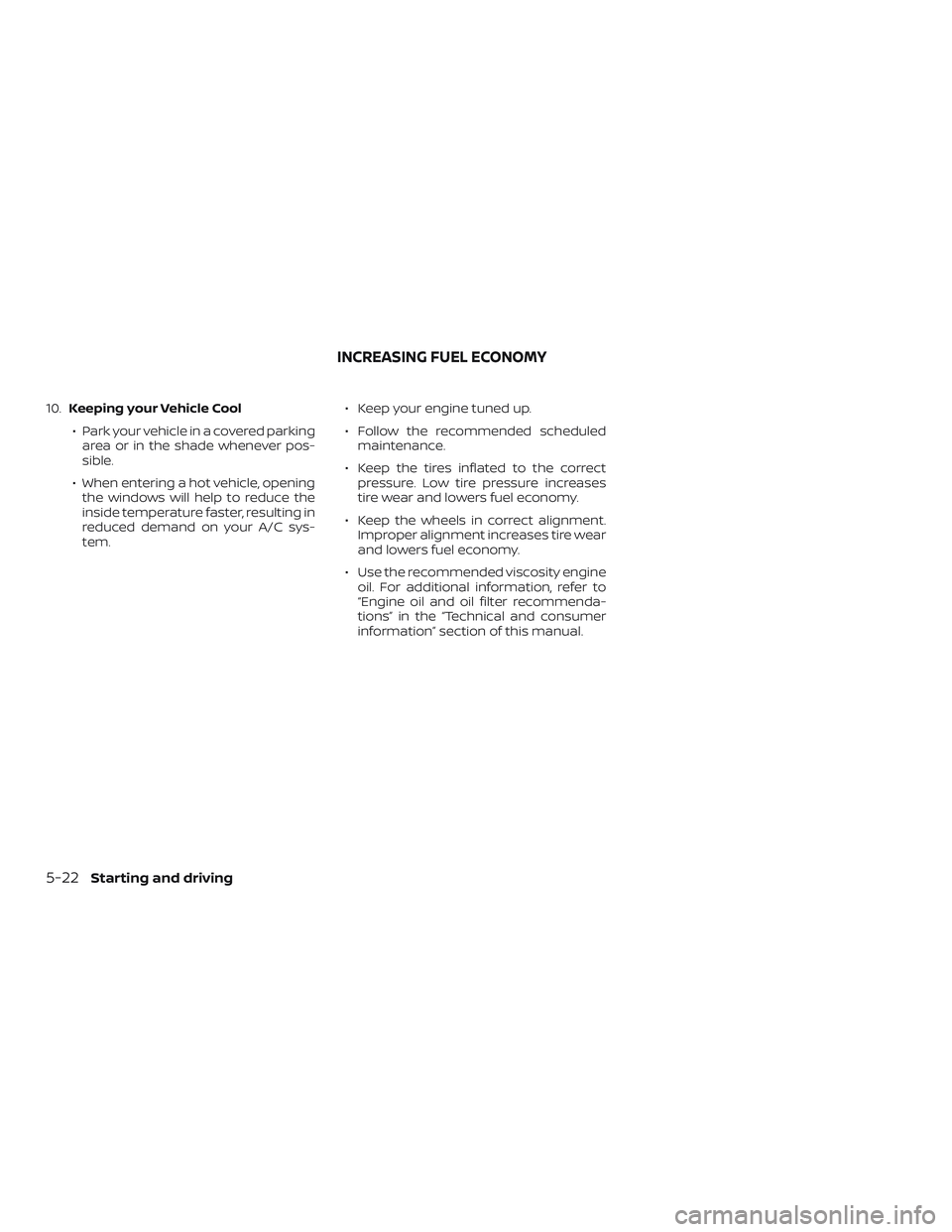
10.Keeping your Vehicle Cool
∙ Park your vehicle in a covered parking
area or in the shade whenever pos-
sible.
∙ When entering a hot vehicle, opening
the windows will help to reduce the
inside temperature faster, resulting in
reduced demand on your A/C sys-
tem.∙ Keep your engine tuned up.
∙ Follow the recommended scheduled
maintenance.
∙ Keep the tires inflated to the correct
pressure. Low tire pressure increases
tire wear and lowers fuel economy.
∙ Keep the wheels in correct alignment.
Improper alignment increases tire wear
and lowers fuel economy.
∙ Use the recommended viscosity engine
oil. For additional information, refer to
“Engine oil and oil filter recommenda-
tions” in the “Technical and consumer
information” section of this manual.
INCREASING FUEL ECONOMY
5-22Starting and driving
Page 269 of 354
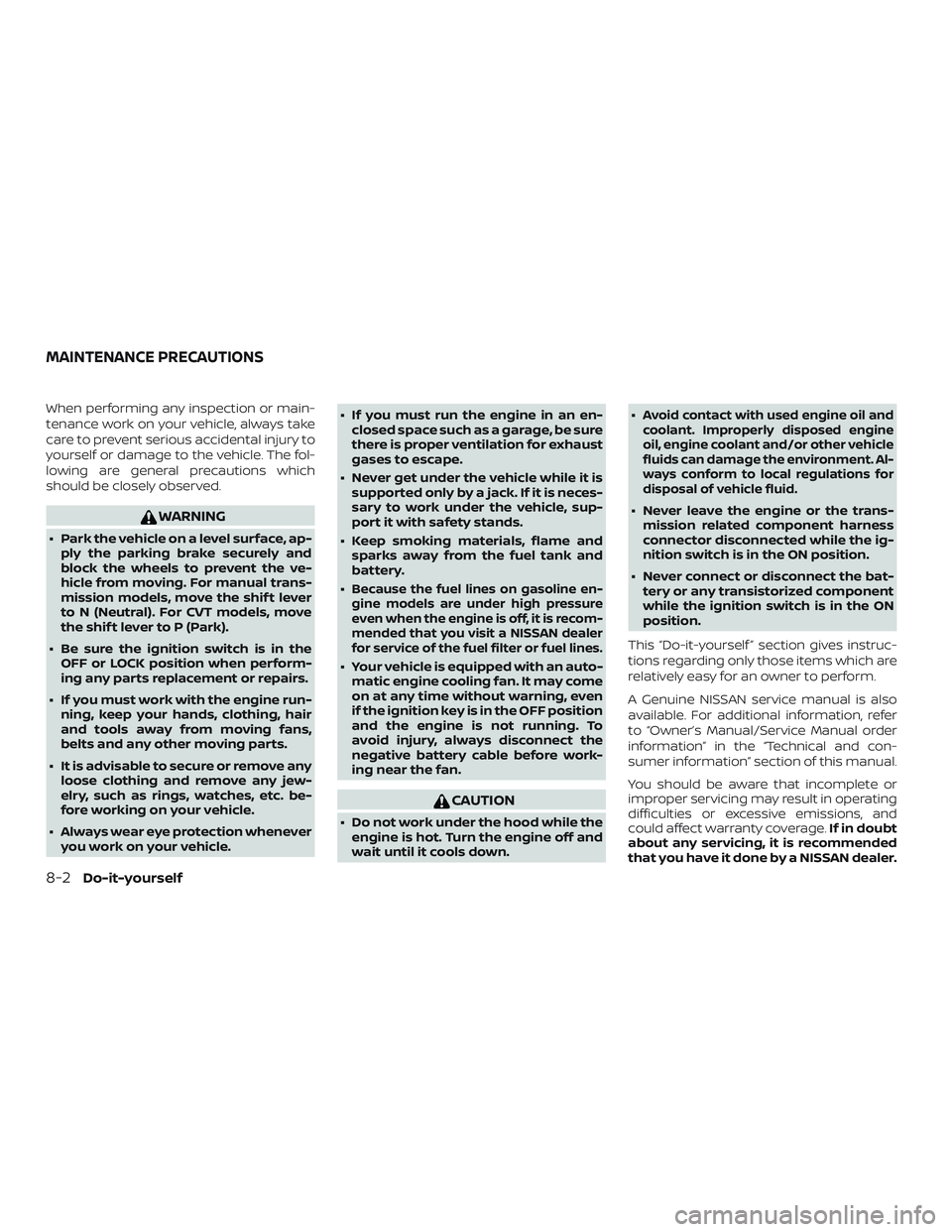
When performing any inspection or main-
tenance work on your vehicle, always take
care to prevent serious accidental injury to
yourself or damage to the vehicle. The fol-
lowing are general precautions which
should be closely observed.
WARNING
∙ Park the vehicle on a level surface, ap-
ply the parking brake securely and
block the wheels to prevent the ve-
hicle from moving. For manual trans-
mission models, move the shif t lever
to N (Neutral). For CVT models, move
the shif t lever to P (Park).
∙ Be sure the ignition switch is in the
OFF or LOCK position when perform-
ing any parts replacement or repairs.
∙ If you must work with the engine run-
ning, keep your hands, clothing, hair
and tools away from moving fans,
belts and any other moving parts.
∙ It is advisable to secure or remove any
loose clothing and remove any jew-
elry, such as rings, watches, etc. be-
fore working on your vehicle.
∙ Always wear eye protection whenever
you work on your vehicle.∙ If you must run the engine in an en-
closed space such as a garage, be sure
there is proper ventilation for exhaust
gases to escape.
∙ Never get under the vehicle while it is
supported only by a jack. If it is neces-
sary to work under the vehicle, sup-
port it with safety stands.
∙ Keep smoking materials, flame and
sparks away from the fuel tank and
battery.
∙
Because the fuel lines on gasoline en-
gine models are under high pressure
even when the engine is off, it is recom-
mended that you visit a NISSAN dealer
for service of the fuel filter or fuel lines.
∙ Your vehicle is equipped with an auto-
matic engine cooling fan. It may come
on at any time without warning, even
if the ignition key is in the OFF position
and the engine is not running. To
avoid injury, always disconnect the
negative battery cable before work-
ing near the fan.
CAUTION
∙ Do not work under the hood while the
engine is hot. Turn the engine off and
wait until it cools down.∙
Avoid contact with used engine oil and
coolant. Improperly disposed engine
oil, engine coolant and/or other vehicle
fluids can damage the environment. Al-
ways conform to local regulations for
disposal of vehicle fluid.
∙ Never leave the engine or the trans-
mission related component harness
connector disconnected while the ig-
nition switch is in the ON position.
∙ Never connect or disconnect the bat-
tery or any transistorized component
while the ignition switch is in the ON
position.
This “Do-it-yourself ” section gives instruc-
tions regarding only those items which are
relatively easy for an owner to perform.
A Genuine NISSAN service manual is also
available. For additional information, refer
to “Owner’s Manual/Service Manual order
information” in the “Technical and con-
sumer information” section of this manual.
You should be aware that incomplete or
improper servicing may result in operating
difficulties or excessive emissions, and
could affect warranty coverage.If in doubt
about any servicing, it is recommended
that you have it done by a NISSAN dealer.
MAINTENANCE PRECAUTIONS
8-2Do-it-yourself